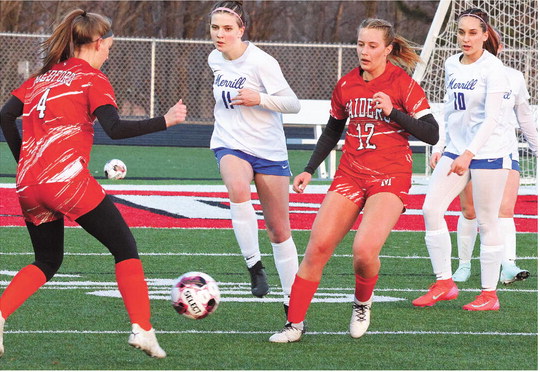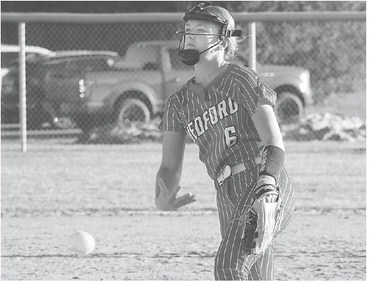A STRONG FINISH AT STATE


WIAA DIV. 2 STATE GYMNASTICS CHAMPIONSHIPS
Veronica Mateer completes a round off on the balance beam and Ellison Carbaugh jumps into her vault routine during team competition Friday afternoon at the WIAA Division 2 state gymnastics championships at Wisconsin Rapids. The Medford-Colby squad placed seventh out of 10 teams on Friday with a score of 135.2167, the Raiders’ second-highest mark of the season.
Krause, Malchow nearly medal; team is 7th
The Medford-Colby gymnastics coop didn’t miss a new program-record team score by much on Friday while Kate Malchow and Kyla Krause didn’t miss earning medals by much Saturday during individual competition at the WIAA Division 2 state championship meet held at Wisconsin Rapids.
All in all it was a solid weekend for the Raiders, who earned the program’s fifth straight state appearance as a team and recorded its highest score in that five-year run at 135.2167 in the team competition Friday.
That was good for seventh place out of 10 Division 2 teams, the same place the Raiders finished a year ago, and just missed the school record of 135.625 the team set Feb. 11 at Ashland. The Raiders ended their day with a big finish in the floor exercise to make a run at the school record and a run at getting past River Falls for sixth place. The Wildcats barely held on to sixth with their 135.3333 points.
On Saturday, Krause and Malchow both felt they had some hits and misses in their individual competition, but their hits had them thinking they might hear their names called when medals were presented at day’s end. As it turned out, Krause missed by one spot while taking seventh on the vault and Malchow was 0.134 points shy while taking ninth on the uneven bars.
“The big push for me was for these girls to do really well at state,” Medford head coach Steve Cain said of qualifying for the fifth straight year. “That was the big thing. I think that the girls who went this weekend from Medford, they can basically say it’s another one for the books, ending another great season for these girls.”
Individual day
Krause’s score of 9.333 on the vault Saturday came on her second attempt and easily was Medford’s highest score of the weekend. She also got a 9.133 on vault during Friday’s team competition. Krause took a big jump from her first attempt Saturday, which got an 8.633 after she missed her landing, and wound up finishing just 0.017 points behind Reedsburg’s Emily Craker for the last spot on the awards podium.
“In all three years I’ve been next up to place,” Krause said. “But I still think I did pretty good, getting a 9.333 at state. That’s the highest I’ve gotten at state.”
She said a slight adjustment made all the difference in hitting that last attempt.
“I just told myself to take one step back instead of under rotating it because then my chest was up higher and you score higher,” Krause said.
Malchow’s ninth-place score of 8.733 on the bars was her second-best score of the season and her career behind the 8.85 she’s hit twice, including last year at state which was a school record at the time. She got a solid 8.717 in team competition Friday as well.
“It was all right,” Malchow said of her high-scoring routine. “It could have been better probably but it was decent.”
Gabby Dixon of Elkhorn got the sixthplace medal with an 8.867, while the Viroqua Co-op’s Morgan Siekert (8.85) and West Salem Co-op’s Natalie Peterson (8.833) were also just ahead of Malchow.
“That’s how close it gets,” Cain said. “Kate placed ninth on bars with an 8.733 and she did it beautifully. She had trouble with this one warming up, but she landed her double back dismount beautifully.”
While the final scores didn’t show it, Malchow felt she may have actually been closer to medaling on the balance beam. One little fall there cost her at least a half-point and put her in 19th place at 8.433. Mel Princl of West Bend West got the sixth-place medal at 8.917.
“I probably would have been really close on beam if I didn’t fall,” Malchow said. “That was the same thing the last couple years. If I didn’t fall I would’ve placed.”
“On individual day for them to do everything they did on Friday as a team, then to turn around the next morning, go back and then do everything again, it challenges even the very best,” Cain said. “It also offers these girls another day before the weekend’s over to hopefully get some personal records or even break school records. It gives them that opportunity. They gave 110%.”
Malchow finished with 34.667 allaround points, good for 16th of 25 allaround competitors, while Krause finished 23rd in the all-around competition with 33.733 total points.
Malchow tied Dixon for 21st on vault with an 8.75 and took 22nd on the floor exercise with a strong routine that earned an 8.75. Krause placed 23rd on the balance beam with an 8.15 and her floor routine earned a solid score of 8.733. Unfortunately on the bars, which is typically one of her strongest events, Krause missed one of her giants and had to restart, dropping her to a 7.517 and 25th place. The day before in team competition, she hit her routine from start to finish and got an 8.9, which would’ve won a medal had she done that Saturday.
Without question, the junior’s goal for next year is set.
“To place on one thing at state,” she said. “That was my goal this year.”
Cassi Hansen, a senior from state team champion Nicolet, won the Division 2 allaround championship by totaling 37.417 points in Saturday’s individual competition, almost a full point more than Waupun sophomore Abby Roecker (36.583). Elkhorn sophomore Kaylee Frank was third with 36.567 points, Sparta senior Ella Hemker was fourth with 36.5, Rice Lake sophomore Avery Ash was fifth with 36.233 points and Viroqua Co-op sophomore Isabell Korn was sixth with 36.083 all-around points.
Ash won the state vault championship with a score of 9.483, sneaking past Hemker (9.467) and Nicolet junior Ezzy Mauermann (9.45). Madilyn Fisher of Prairie du Chien-Fennimore and Morgan Siekert of the Viroqua Co-op tied for fourth at 9.367, not far ahead of Krause. Roecker won the balance beam championship with her score of 9.267, just ahead of Ash (9.167), Hansen (9.083) and Ryann Wesley of Whitefish Bay (9.083).
Hansen won the bars title at 9.6 and the floor title at 9.433. Also medaling on bars not far ahead of Malchow were Frank (9.45), Craker (9.217), Hemker (8.933) and Taliya Michlig of the West Salem Co-op (8.917). Frank was second on the floor with a 9.383, tying Abby Miller of the Gale-Ettrick-Trempealeau Co-op. Hemker was fourth at 9.367.
Team day
Much like the day last month where the Raiders set their new team record score, there weren’t many personal records set Friday, nor did Medford-Colby set a season high score in any of the four events, but the scores were consistent enough to put them over the 135 mark for only the second time this season.
“I think it was pretty good,” Malchow said. “It was probably one of our better meets. We probably still could have done a little better than what we did, but it wasn’t bad at all.”
“The lineup was done so that we could go to state, do well at state and that’s the one thing that will always be a good memory,” Cain said. “They all did good. We placed seventh in Division 2 with a score that was higher than sectionals. It’s an accomplishment they can be proud of. They were only 0.425 away from breaking the team record again. When you do that at state, that is phenomenal.”
The Raiders had a long wait of about two hours after the march-in to finally compete on the vault, but for the most part that event was worth the wait. Krause led off, as she always does, and hit two solid Yurchenkos, earning a 9.1 and then her 9.133. Malchow landed her Yurchenkos as well, getting an 8.633 on her first attempt and then improving to an 8.767.
Freshman Delaina Meyer’s first state event earned an 8.367 on her first attempt and then an 8.417 on her second. Junior Kaileigh Mientke improved over her sectional score of 8.15 by getting an 8.2 on her first attempt and improving to 8.283 on the second, good for her highest-ever varsity score. Junior Ellison Carbaugh competed for the second straight year and got a 7.833 on her best vault.
The Raiders totaled 34.6 points in the event, ranking fifth out of the 10 teams.
From there, the team went to the uneven bars where Krause got a 9.0 from one judge and an 8.95 from another as part of her final score of 8.9. Following Malchow’s 8.717, Meyer earned a 7.767, sophomore Shayla Radlinger got a 7.5 in her second state appearance in the event and senior Avery Purdy got a score of 7.35. Medford-Colby’s event score of 32.883 ranked sixth among the teams.
While Medford-Colby’s team score of 33.117 on the balance beam was about a point off a season high, the Raiders did well to stay on the beam with their five entrants combining to fall just once and ranked fourth among the 10 teams.
Despite having that fall, Malchow led the Raiders with an 8.533. Krause earned an 8.367, sophomore Veronica Mateer got into the 8s with an 8.05 that nearly equaled last year’s 8.067 and freshman Bridget Cloud debuted at state with a solid 7.983. Two of the three judges had her in the 8s. Purdy closed her career by putting a tough outing on bars behind her and getting a solid 8.167 on the beam.
“My heart really went out to Avery because the one thing she wanted to do as a senior was to qualify individually again,” Cain said. “She was one of our hardest workers. As a senior and with what she wanted to do this year, she was super dedicated, super focused on her tasks. She had her goals set. She wasn’t going to let anything or anybody take her away from that. She gave more than 100% trying to do that. To me, that means more than what the end result was.”
After another long break, the Raiders finished the day on the floor exercise and earned their highest event score of the day at 34.617 points. Krause noted the energy for that last event was high as they and their Division 1 counterparts in the rotation, Chippewa Falls, cheered each other on and the Raiders responded with Krause earning an 8.967, Malchow getting an 8.817, Meyer earning an 8.5, Mateer getting an 8.333, well ahead of last year’s 7.767 and Radlinger posting an 8.3, easily beating last year’s 7.2.
All-around scores aren’t officially kept on team day at state, but Krause’s total of 35.367 points for the day came close to her school record of 35.55 and Malchow’s total of 34.834 was her best of the season.
Nicolet was the favorite going into the team competition and the Knights didn’t disappoint, scoring 142.75 points. The West Salem Co-op earned the silver trophy with 138 points, just ahead of Elkhorn’s 137.9167. Mount Horeb (136.05) and West Bend West (135.6667) were fourth and fifth. The Raiders finished ahead of Reedsburg (132.6167), the Platteville Co-op (132.35) and the Ashland Coop
Raiders’ logo on their cheek, as shown by Kaileigh Mientke. Upper left: Kyla Krause catches the high bar as she transitions to it during her team routine Friday that earned an 8.9. Lower left: Kate Malchow has both hands on the balance beam during her individual routine on Saturday, which earned an 8.433.
(129.9333).
Malchow and Purdy are the team’s lone losses to graduation. Malchow has another big meet in her future as she will be part of Team Wisconsin in the National High School Gymnastics Association’s Senior Invitational in Fort Myers, Fla. May 18-20. The rest of the team could return next year, looking to continue the Raiders’ run of excellence.
“The girls qualified as champions,” Cain said. “It’s the fifth year in a row that they qualified, fourth year in a row as champions at sectionals. For the seniors it’s very bittersweet. They worked hard to be where they’re at, no doubt. All of the girls worked hard to achieve what they achieved.”

Above: During WIAA Division 2 state team competition Friday all of the Medford-Colby gymnasts competed with aMATT FREY/THE STAR NEWS









